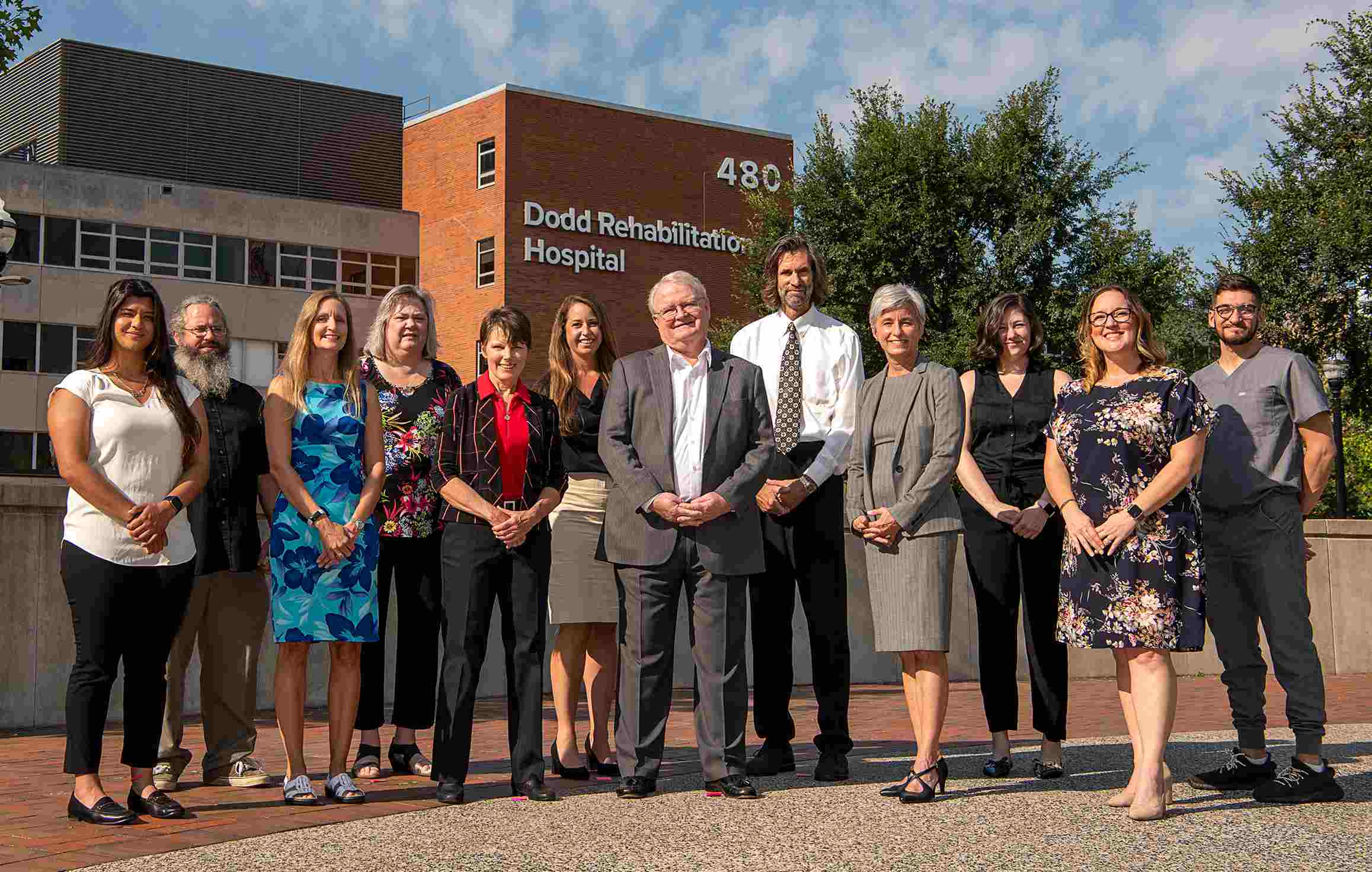
Traumatic brain injury research bolstered by $16 million in federal funding

Ohio Valley Center for Brain Injury Prevention and Rehabilitation, part of The Ohio State University Wexner Medical Center’s Neurological Institute, conducts research, provides education and develops programs to improve the quality of life of persons who experience traumatic brain injury (TBI). The center serves individuals, families and professionals throughout North America, both as a TBI Model System and as the designated lead agency for the Ohio Brain Injury Program and the Star Behavioral Health Providers program.
The Comparing Treatment Approaches to Promote Inpatient Rehabilitation Effectiveness for Traumatic Brain Injury (CARE4TBI)
CARE4TBI project is a pragmatic, stakeholder-driven observational study which aims to: 1) standardize electronic medical record (EMR) documentation of rehabilitation therapy to allow extraction for research and operations, 2) compare the effectiveness of well-defined rehabilitation approaches to improve community participation and functional independence of patients with TBI, and 3) identify patient, provider, setting and post-discharge factors that modify the effect of therapy on key outcomes. In addition to rehabilitation clinicians, persons living with TBI from the Ohio Valley Center Advisory Council will provide input on study implementation and interpretation of findings. This project is supported by the National Institute of Neurological Disorders and Stroke of the National Institutes of Health under Award Number UG3NS117844.

Do state supports for persons with brain injury affect outcomes in the 5 Years following acute rehabilitation? Corrigan JD, Vuolo M, Bogner J, Botticello AL, Pinto SM, Whiteneck GG. Health Place. 2021 Nov;72:102674. doi: 10.1016/j.healthplace.2021.102674. Epub 2021 Oct 23.
Comparative effectiveness of a brief intervention for alcohol misuse following traumatic brain injury: A randomized controlled trial. Bogner J, Corrigan JD, Peng J, Kane C, Coxe K.Rehabil Psychol. 2021 Oct 7. doi: 10.1037/rep0000405.
A Descriptive Analysis of the Epidemiology and Motivations for Laser Tattoo Removal in an Underserved Population. Huang S, Blissett G, Pei BA, Balac N, Bogner J, Reilly JM. J Community Health. 2021 Sep 4. doi: 10.1007/s10900-021-01024-w. Online ahead of print.PMID: 34480684
Patterns of Functional Change Five to Ten Years after Moderate-Severe Traumatic Brain Injury. Hammond FM, Malec JF, Corrigan JD, Whiteneck GG, Hart T, Dams-O'Connor K, Novack TA, Bogner J, Dahdah MN, Eagye CB, Sevigny M, Ketchum JM. J Neurotrauma. 2021 Jun 1;38(11):1526-1534. doi: 10.1089/neu.2020.7499. Epub 2021 Apr 29.
Quasi-Contextualized Speech Treatment in Traumatic Brain Injury Inpatient Rehabilitation: Effects on Outcomes During the First Year After Discharge. Beaulieu CL, Peng J, Hade EM, Montgomery E, Gilchrist K, Corrigan JD, Horn SD, Bogner J. J Head Trauma Rehabil. 2021 Sep-Oct 01;36(5):E312-E321. doi: 10.1097/HTR.0000000000000649.
Improving transition from inpatient rehabilitation following traumatic brain injury: Protocol for the BRITE pragmatic comparative effectiveness trial. Fann JR, Hart T, Ciol MA, Moore M, Bogner J, Corrigan JD, Dams-O'Connor K, Driver S, Dubiel R, Hammond FM, Kajankova M, Watanabe TK, Hoffman JM. Contemp Clin Trials. 2021 May;104:106332. doi: 10.1016/j.cct.2021.106332. Epub 2021 Feb 27.
Association of Lifetime History of Traumatic Brain Injury With Prescription Opioid Use and Misuse Among Adults. Adams RS, Corrigan JD, Ritter GA, Hagemeyer A, Pliskin MB, Reif S. J Head Trauma Rehabil. 2021 Sep-Oct 01;36(5):328-337. doi: 10.1097/HTR.0000000000000729.
Marital Stability Over 10 Years Following Traumatic Brain Injury. Hammond FM, Sevigny M, Backhaus S, Neumann D, Corrigan JD, Charles S, Gazett H.J Head Trauma Rehabil. 2021 Jul-Aug 01;36(4):E199-E208. doi: 10.1097/HTR.0000000000000674.
Prevalence of Drinking Within Low-Risk Guidelines During the First 2 Years After Inpatient Rehabilitation for Moderate or Severe Traumatic Brain Injury. Adams RS, Ketchum JM, Nakase-Richardson R, Katz DI, Corrigan JD. Am J Phys Med Rehabil. 2021 Aug 1;100(8):815-819. doi: 10.1097/PHM.0000000000001753.
Staff Traumatic Brain Injury Skill Builder: Evaluation of an Online Training Program for Paraprofessional Staff Serving Adults With Moderate-Severe TBI. Powell LE, Gau J, Glang A, Corrigan JD, Ramirez M, Slocumb J. J Head Trauma Rehabil. 2021 Sep-Oct 01;36(5):E329-E336. doi: 10.1097/HTR.0000000000000661.
Demographic and Mental Health Predictors of Arrests Up to 10 Years Post-Traumatic Brain Injury: A Veterans Affairs TBI Model Systems Study. Miles SR, Silva MA, Neumann D, Dillahunt-Aspillaga C, Corrigan JD, Tang X, Eapen BC, Nakase-Richardson R. J Head Trauma Rehabil. 2021 Jul-Aug 01;36(4):E240-E248. doi: 10.1097/HTR.0000000000000640.
Prevalence of Medical and Psychiatric Comorbidities Following Traumatic Brain Injury. Hammond FM, Corrigan JD, Ketchum JM, Malec JF, Dams-OʼConnor K, Hart T, Novack TA, Bogner J, Dahdah MN, Whiteneck GG. J Head Trauma Rehabil. 2019 Jul/Aug;34(4):E1-E10. doi: 10.1097/HTR.0000000000000465.
Alcohol Use Disorder and Traumatic Brain Injury. Weil ZM, Corrigan JD, Karelina K. Alcohol Res. 2018;39(2):171-180.
National Institute of Neurological Disorders and Stroke (NINDS) of the National Institutes of Health (NIH) #UG3NS117844
National Institute on Disability, Independent Living, and Rehabilitation Research (NIDILRR) #90DPTB0001
Ohio Department of Mental Health and Addiction Services #2200099